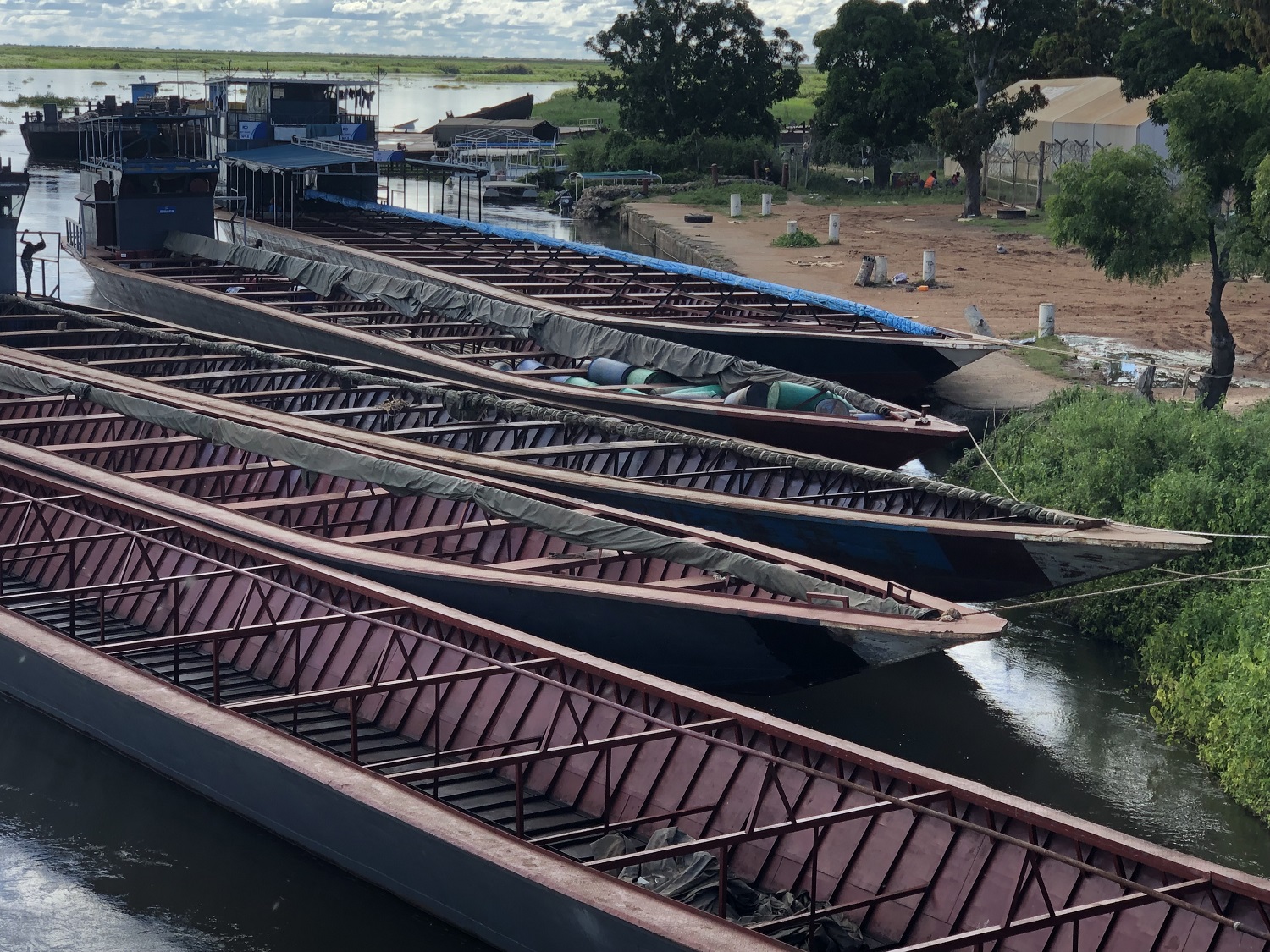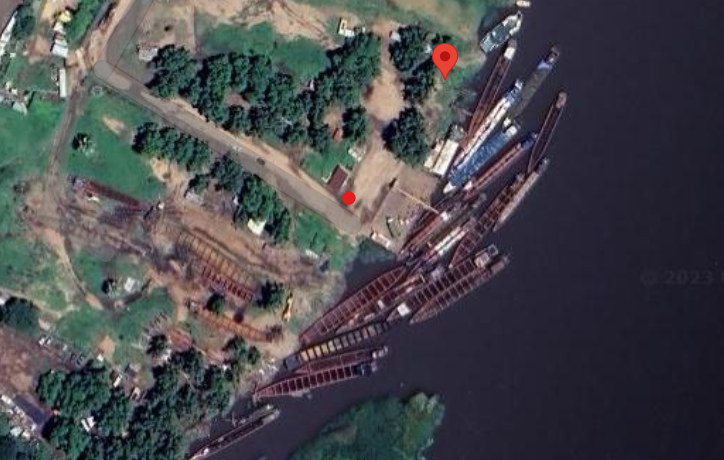South Sudan, Republic of - 2.1 Juba Port Assessment
South Sudan, Republic of - 2.1.1 Port of Total/Malualgurubar
Port Overview
Total/Malualgurubar port is in Bor South Sudan along Juba-Bor highway, it is under the management of WFP and is along the main river (River Nile). Barges and boats are used in this port mainly for loading/offloading of food commodities and NFIs (WFPs/ Logistics cluster). Some barge and boat owners have speedboats and depending on need, they can be hired to escort the barge and boat movements. The boat/barge operators ran the operations in all rivers the locations. The port operates in all locations along the North and has offshoots to Mangala, Minkaman and Juba.
The port has a well confined docking site for barges and boats however vessel dock at intervals. The offshoot from Juba highway to the port is murram road of about half KM and Cargo handling both loading and offloading is done by local labours and the rates are fluctuating depending on existing country’s economy.
Key port information may also be found at: http://www.maritime-database.com
|
Port Location and Contact |
|
|---|---|
|
Country |
South Sudan |
|
Province or District |
Jonglei state, Bor- South |
|
Nearest Town or City with Distance from Port |
Bor Town DISTANCE (15) |
|
Port's Complete Name |
Malualgorubar (Total) port |
|
Latitude |
6.11569 |
|
Longitude |
31.57925 deg Alt 468m |
|
Managing Company or Port Authority |
WFP management |
|
Management Contact Person |
WFP-Logistics Unit |
|
Nearest Airport and Airlines with Frequent International Arrivals/Departures |
AIRPORT NAME: Bor Airport LIST OF INTERNATIONAL CARRIERS: N/A |
Port Picture

Description and Contacts of Key Companies
The commercial companies do not have permanent presence at the port, however all WFP contracted commercial companies are active in this port depending on need and boat/barge cargo allocations granted to them, they can then position their boats and barges. Companies of heavy handling equipment’s (Cranes) operate at this port on request basis, examples of boat and barge companies; Ludier General Trading CO. Ltd, Transway Transporters and Logistics, Mango Tree Marine, Sharrow Trading, and investment CO. Ltd, interlink Inc, Northgate General Trading CO. Ltd for the boat operators and B&S group, Nile Barges, and Internet International trade and Transport Co/ltd for the barges.
For more information on port contacts, please see the following link: 4.4 Port and Waterways Companies Contact List.
Port Performance
The port has a well confined docking site for barges and boats however vessels dock at intervals due to insufficient docking area. The channel draft is estimated to 2–3-meter depth and reduces during dry season. Only metallic Barges and Boats of type used in South Sudan and neighbouring countries sharing the river Nile can operate in this port and no other larger vessel with containerized lot. The port is solely used for transportation of humanitarian Cargo mainly WFP food items and Non- Food Items for UN agencies and humanitarian Organizations. The port capacity is limited to loading of one vessel at a time, the port has no handling equipment, and most cargo is handled manually. The port is accessible from the offshoot of Juba-Bor Highway and is located about half kilometre from the highway, the access road is murram and can support the movement of 40Mt truck capacity. The port is located on the main river Nile, and it serves many locations downstream the river Nile and other sub rivers and waterways like zarf, Sobat, and lake Tayar. The loading capacity is about 200-300Mt per day and the lead time is as per size of the vessel.
|
Seasonal Constraints |
||
|---|---|---|
|
Occurs |
Time Frame |
|
|
Rainy Season |
Yes |
From April to November |
|
Major Import Campaigns |
No |
N/A |
|
Low water levels making access less navigable during dry season and during rainy season movement of water weeds causing blockage to certain waterways. |
||
|
Handling Figures for 2023 |
|
|---|---|
|
Vessel Calls |
Estimated 10 barge movement throughout the year, with approtimately-1500Mt per barge. Estimated 200 boat movement through the year with boat capacity ranging from 150-250 Mt per boat.
|
|
Container Traffic (TEUs) |
N/A |
|
Handling Figures Bulk and Break Bulk for 2023 |
|
|---|---|
|
Bulk (MT) |
N/A |
|
Break bulk (MT) |
45000MT |
Discharge Rates and Terminal Handling Charges
Handling charges depends on weight of cargo, quantity, and type of cargo. The rates are determined by leader of port union and barge/boat operators. The Non-food items rates are negotiable while the rate for food commodities is fixed.
Berthing Specifications
|
Type of Berth |
Quantity |
Length (m) |
Maximum Draft (m) |
Comments |
|---|---|---|---|---|
|
Conventional Berth |
0 |
N/A |
N/A |
|
|
Container Berth |
0 |
N/A |
N/A |
|
|
Silo Berth |
0 |
N/A |
N/A |
|
|
Berthing Tugs |
0 |
N/A |
N/A |
|
|
Water Barges |
|
Barges and boats are moored on trees along riverbanks as there are no permanent mooring fixtures at the port.
General Cargo Handling Berths
|
Cargo Type |
Berth Identification |
|---|---|
|
Imports - Bagged Cargo |
N/A |
|
Exports - Bagged Cargo |
N/A |
|
Imports and Exports - RoRo |
N/A |
|
Other Imports |
N/A |
Port Handling Equipment
Is the port equipment managed by the government or privately?
The port is managed by WFP and no existence of port equipment’s. For Handling of heavy equipment’s, such as generators and containerized cargo, cranes are hired from private companies and for the bagged, cartoons and other parcel cargo, porters physically handle both the loading and offloading at a cost. Hired commercial cranes helps in loading and offloading of containers depending on request. The rates are as per the contract, ranging from 600-1200$ per workload/rotations.
|
Equipment |
Available |
Total Quantity and Capacity Available |
Comments on Current Condition and Actual Usage |
|---|---|---|---|
|
Dockside Crane |
No |
No |
Hired commercial cranes |
|
Container Gantries |
No |
N/A |
N/A |
|
Mobile Cranes |
No |
No |
Hired commercial cranes |
|
Reachstacker |
No |
N/A |
N/A |
|
RoRo Tugmaster (with Trailer) |
No |
N/A |
N/A |
|
Grain Elevator with Bagging Machines |
No |
N/A |
N/A |
|
Transtainer |
No |
N/A |
N/A |
|
Forklifts |
No |
N/A |
Hired commercial forklifts |
Container Facilities
No container facilities neither storage.
|
Facilities |
20 ft |
40 ft |
|---|---|---|
|
Container Facilities Available |
None |
None |
|
Container Freight Station (CFS) |
N/A |
N/A |
|
Refrigerated Container Stations |
N/A |
N/A |
|
Other Capacity Details |
N/A |
N/A |
|
Daily Take Off Capacity |
N/A |
N/A |
|
Number of Reefer Stations |
N/A |
N/A |
|
Emergency Take-off Capacity |
N/A |
N/A |
|
Off take Capacity of Gang Shift |
N/A |
N/A |
Customs Guidance
The port is mainly involved with coordination of WFP- humanitarian food and Non-Food items that is exempted from custom taxation. The port mainly serves deliveries within the country with no cross-border operation.
For more information on customs in South Sudan, please see the following link: 1.3 Customs Information.
Terminal Information
MULTIPURPOSE TERMINAL
N/A
GRAIN AND BULK HANDLING
N/A
MAIN STORAGE TERMINAL
The port is connected to warehouse premise with 30 existing Mobile storage Units (MSUs) for indoor storage and a large yard for outdoor storage. The warehouse serves as a hub for storage of food and Non-food supplies for further river deliveries.
|
Storage Type |
Number of Storage Facilities |
Area (m2) |
|---|---|---|
|
Bagged Cargo |
27(about 12000Mt) |
7500 |
|
Refrigerated Cargo |
0 |
0 |
|
General Cargo |
3(1500CBM) |
840 |
Stevedoring
There are no stevedoring companies however the offloading is directly arranged by boat and barge operators and casual labourers (porters). The rates for loading and offloading varies depending on type and weight of cargo. There is no shortage of labours, there can be available more than 100 labours available to perform any task.
Hinterland Information
Road is used to move cargo out of the port and access to the port is only to commercial trucks carrying WFP Food and other humanitarian cargo.
Port Security
The access road to total port is through the WFP warehouse facility which has security personnel, and all vehicles and people requiring access into the port must clear with the security personnel. The area is fenced, has solar lighting and minor firefighting facilities such as fire extinguishers distributed in MSUs premises. During loading and offloading, boat and barge operators normally have their own security that remains on water vessels.
|
Security |
|
|---|---|
|
ISPS Compliant |
No |
|
Current ISPS Level |
N/A |
|
Police Boats |
No |
|
Fire Engines |
No |
